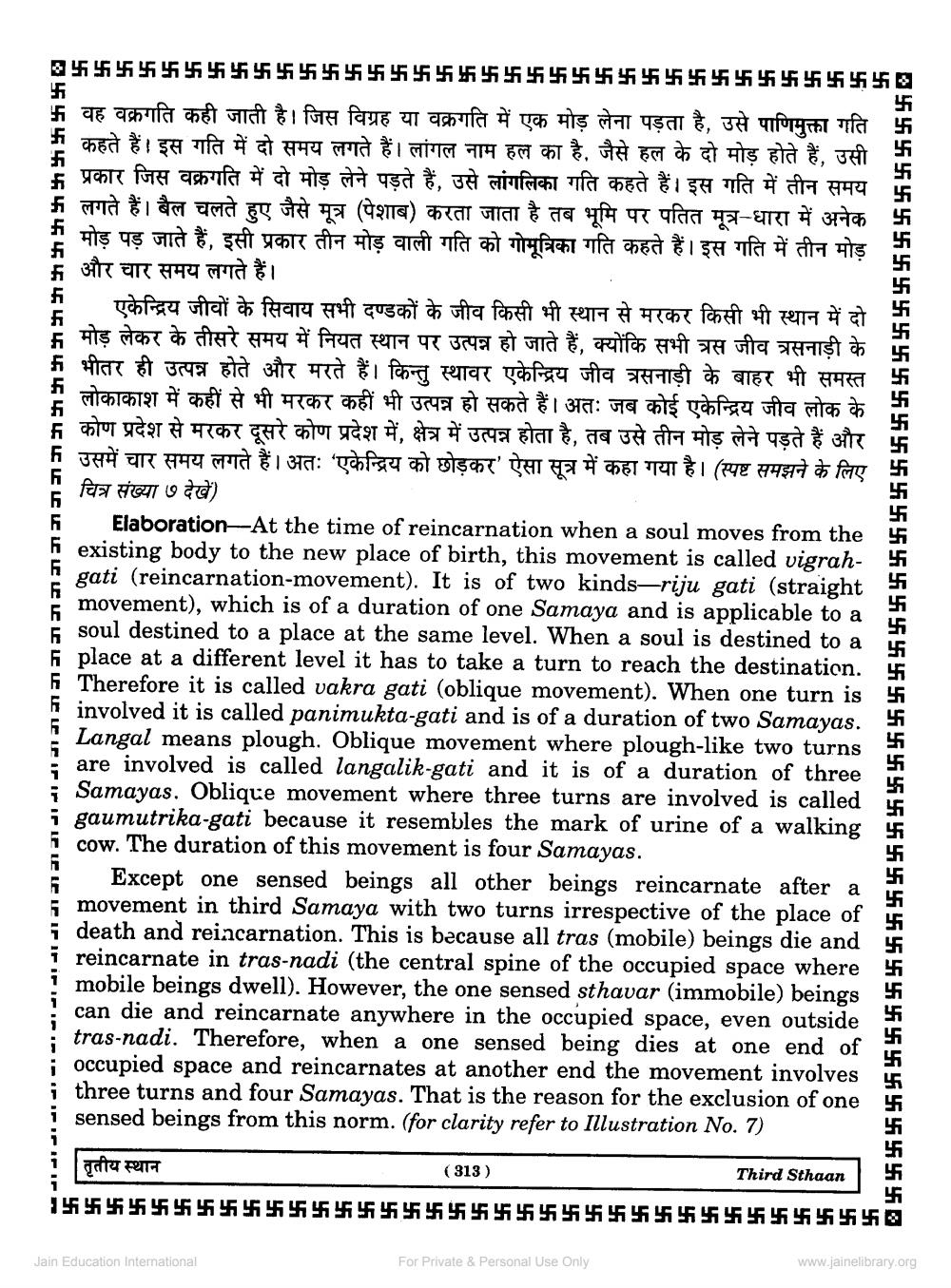________________
)
ת ת ה
ת ת ת
ת ת ת
ת ת
ת ת ת ת
ת ת
ת ת ת ת
ॐ वह वक्रगति कही जाती है। जिस विग्रह या वक्रगति में एक मोड़ लेना पड़ता है, उसे पाणिमुक्ता गतिम + कहते हैं। इस गति में दो समय लगते हैं। लांगल नाम हल का है, जैसे हल के दो मोड़ होते हैं, उसी
प्रकार जिस वक्रगति में दो मोड़ लेने पड़ते हैं, उसे लांगलिका गति कहते हैं। इस गति में तीन समय , लगते हैं। बैल चलते हुए जैसे मूत्र (पेशाब) करता जाता है तब भूमि पर पतित मूत्र-धारा में अनेक 5
मोड़ पड़ जाते हैं, इसी प्रकार तीन मोड़ वाली गति को गोमूत्रिका गति कहते हैं। इस गति में तीन मोड़ और चार समय लगते हैं।
एकेन्द्रिय जीवों के सिवाय सभी दण्डकों के जीव किसी भी स्थान से मरकर किसी भी स्थान में दो # मोड़ लेकर के तीसरे समय में नियत स्थान पर उत्पन्न हो जाते हैं, क्योंकि सभी त्रस जीव त्रसनाड़ी के
भीतर ही उत्पन्न होते और मरते हैं। किन्तु स्थावर एकेन्द्रिय जीव त्रसनाड़ी के बाहर भी समस्त लोकाकाश में कहीं से भी मरकर कहीं भी उत्पन्न हो सकते हैं। अतः जब कोई एकेन्द्रिय जीव लोक के कोण प्रदेश से मरकर दूसरे कोण प्रदेश में, क्षेत्र में उत्पन्न होता है, तब उसे तीन मोड़ लेने पड़ते हैं और उसमें चार समय लगते हैं। अतः ‘एकेन्द्रिय को छोड़कर' ऐसा सूत्र में कहा गया है। (स्पष्ट समझने के लिए चित्र संख्या ७ देखें)
Elaboration --At the time of reincarnation when a soul moves from the existing body to the new place of birth, this movement is called vigrahgati (reincarnation-movement). It is of two kinds-riju gati (straight movement), which is of a duration of one Samaya and is applicable to a soul destined to a place at the same level. When a soul is destined to a place at a different level it has to take a turn to reach the destination. Therefore it is called vakra gati (oblique movement). When one turn is involved it is called panimukta-gati and is of a duration of two Samayas. Langal means plough. Oblique movement where plough-like two turns are involved is called langalik-gati and it is of a duration of three Samayas. Oblique movement where three turns are involved is called
gaumutrika-gati because it resembles the mark of urine of a walking 5 cow. The duration of this movement is four Samayas.
Except one sensed beings all other beings reincarnate after a movement in third Samaya with two turns irrespective of the place of
death and reincarnation. This is because all tras (mobile) beings die and i reincarnate in tras-nadi (the central spine of the occupied space where mobile beings dwell). However, the one sensed sthavar (immobile) beings can die and reincarnate anywhere in the occupied space, even outside tras-nadi. Therefore, when a one sensed being dies at one end of
occupied space and reincarnates at another end the movement involves i three turns and four Samayas. That is the reason for the exclusion of one i sensed beings from this norm. (for clarity refer to Illustration No. 7)
卐5555555)))))))))))))))))))))))))))))
ת
LPIT IPIRIPIELELE
ए
तृतीय स्थान
(313)
Third Sthaan
भ
155
55555))))))))))))))))))))
For Private & Personal Use Only
Jain Education International
www.jainelibrary.org




